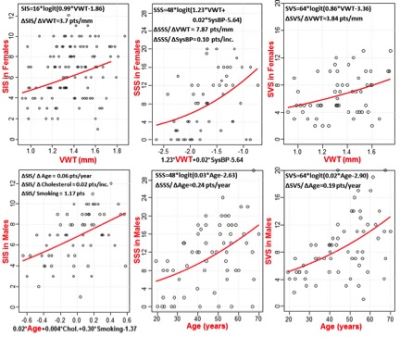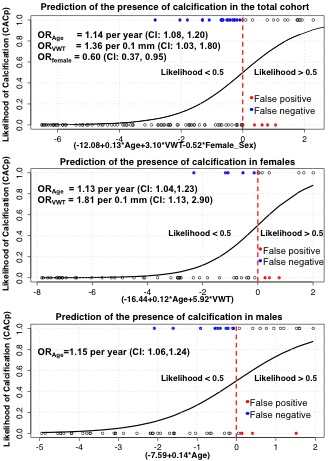0489
Gender-Related Difference in Atherosclerosis: Magnetic Resonance Coronary Artery Wall Thickness is a Predictor of Coronary Plaque Burden in Asymptomatic Young Women1Biomedical and Metabolic Imaging Branch, National Institute of Diabetes and Digestive and Kidney Diseases, Bethesda, MD, United States, 2Diabetes, Endocrinology, and Obesity Branch, National Institute of Diabetes and Digestive and Kidney Diseases, Bethesda, MD, United States, 3Division of Cardiovascular Medicine, Stanford University School of Medicine, Stanford, CA, United States, 4Laboratory of Immunoregulation, National Institutes of Allergy and Infectious Diseases, Bethesda, MD, United States
Synopsis
This study evaluates the potential association of coronary plaque burden with traditional atherosclerosis risk factors and coronary wall thickness (VWT) measured with time-resolved phase-sensitive dual-inversion black-blood TRAPD-MRI. The study demonstrates that there is substantial coronary plaque burden in asymptomatic subjects at low and intermediate Framingham score. In addition, there was evidence of a gender-dimorphic association between the predictors and plaque burden. In women, coronary wall thickness was the strongest and common significant predictor for all plaque burden scores and the presence of calcification. Meanwhile in men, age was the strongest and common predictor of all plaque burden scores and the presence of calcification. This suggests that atherogenesis in women may differ from men and that VWT could supplement traditional risk scores for CAD risk stratification in women. This is in line with the previous studies that demonstrated the impaired utility of these CAD risk score models for women compared to men.
Purpose
To evaluate the relationship between coronary plaque burden measured by Computerized Tomography Angiography (CTA) and coronary wall thickness (VWT) using Magnetic Resonance Imaging (MRI) in a low/intermediate risk asymptomatic population. Additionally, the study assessed the value of this non-invasive radiation-free VWT-MRI method to function as a surrogate marker of plaque burden alone or in tandem with traditional atherosclerosis risk factors.Introduction
Risk stratification for Coronary Artery Disease (CAD) using traditional risk factors in women has not been as effective as in men. Consequently the mortality rate of young women (age<55 years) from CAD has not decreased compared to the general population. While coronary Computerized Tomography Angiography (CTA) provides a comprehensive assessment of coronary plaque burden and might improve CAD risk assessment in women, it is not an ideal screening tool due to the need for contrast agents, beta-blockers administration, and radiation exposure. Coronary wall thickness (VWT) determination using Magnetic Resonance Imaging (MRI) is potentially valuable for identifying early CAD in young women, possibly enabling early intervention. This study evaluates the value of VWT-MRI method for the assessment of coronary plaque burden alone or in combination with traditional risk factors for CAD in a young low-risk population.Materials and Methods
This IRB approved and HIPAA compliant study prospectively recruited 131 asymptomatic subjects with one or more modifiable cardiovascular risk factors. All subjects underwent Multidetector coronary computed tomographic angiography and 3 Tesla (3T) magnetic resonance coronary wall imaging.
Plaque burden and calcification scores with established prognostic value in symptomatic patients were measured1,2. These plaque burden scores included segment stenosis score (SSS), segment plaque volume score (SVS), and segment plaque involvement score (SIS). Calcification scores included presence of calcification (CaP), and Agatston score (CaS). Estimated risk for atherosclerotic disease was calculated using Framingham score (FRS) and the Pooled Cohort Risk Equation for atherosclerotic cardiovascular disease (ASCVD). Right coronary wall thickness was measured using Time-Resolved Phase-Sensitive MRI (TRAPD) at 3T3,4.
Univariable and multivariable generalized nonlinear regression analyses with consideration for interactions with gender were performed to investigate the association of atherosclerotic predictors (age, race, smoking, systolic blood pressure, cholesterol, HDL) and coronary wall thickness with CTA-based plaque burden scores.
Results
The analysis included 62 women and 62 men with low/intermediate Framingham score (FrS) <20%.The age (mean age 45.0 ±14.5 years old) and BMI were not different between the groups. Age, gender, and VWT, individually, were significant predictors of all CTA-based coronary plaque burden scores. Additionally, gender was a significant effect-modifier in association with all plaque burden scores. In contrast to men where age remained the only significant independent predictor of coronary plaque, VWT was the only statistically significant independent predictor of coronary plaque burden scores in women.
Specifically as shown in Figure 1 and Figure 2, in male subgroup, age was the only common statistically significant predictor of SIS, SVS, and SSS with marginal effects of 0.06, 0.19, 0.24 plaque burden points per year (P<0.05), respectively. Additionally, smoking and total Cholesterol were predictors of SIS with marginal effects of 1.17 SIS points per smoking and 0.02 SIS points per Cholesterol unit (mg/dL) increment. For the presence of calcified plaques, age was the only statistically significant predictor of CaP with odds ratio =1.15 per year (P<0.05).
In female subgroup, coronary wall thickness (VWT) was the only common statistically significant predictor of SIS, SVS, and SSS. The SIS, SVS, and SSS add 3.7, 3.84, and 7.87 plaque burden score points per each millimeter wall thickening (P<0.05), respectively. For SSS, SysBP was also a predictor with SSS increasing by 0.1 burden score points per unit mmHg SysBP increment (P<0.05). For the presence of calcified plaques, both age and VWT were the only statistically significant predictors of calcification in females with odds ratio =1.13 per year and 1.81 per 0.1 mm wall thickening (P<0.05), respectively.
Conclusion
There is a strong evidence of a gender-dimorphic association between coronary VWT with CTA-measured plaque burden scores. In younger asymptomatic women and after multivariable nonlinear regression, MRI VWT was the primary predictor of CTA-based coronary plaque burden. Meanwhile in matched asymptomatic men, age was the strongest and common predictor of all plaque burden scores and the presence of calcification. This is in line with the previous studies that demonstrated the impaired utility of the typical CAD risk score models for women compared to men. The study suggests that atherogenesis in women may differ from men and VWT may supplement traditional risk scores for CAD risk stratification in women without the additional risk of radiation from CTA. Further longitudinal studies are required to determine the potential implication and utility of this MRI technique on the preventative management of CAD in women.
Acknowledgements
This work was funded by the intramural program of The National Institute of Diabetes and Digestive and Kidney Diseases, NIH, USA.References
1. Min, J. K. et al. Prognostic value of multidetector coronary computed tomographic angiography for prediction of all-cause mortality. Journal of the American College of Cardiology 50, 1161-1170, (2007).
2. Johnson, K. M. & Dowe, D. A. The detection of any coronary calcium outperforms Framingham risk score as a first step in screening for coronary atherosclerosis. AJR Am J Roentgenol 194, 1235-1243, (2010).
3. Abd-Elmoniem, K. Z., Gharib, A. M. & Pettigrew, R. I. Coronary vessel wall 3-T MR imaging with time-resolved acquisition of phase-sensitive dual inversion-recovery (TRAPD) technique: initial results in patients with risk factors for coronary artery disease. Radiology 265, 715-723, (2012).
4. Abd-Elmoniem, K. Z., Weiss, R. G. & Stuber, M. Phase-sensitive black-blood coronary vessel wall imaging. Magn Reson Med 63, 1021-1030, (2010).
Figures

